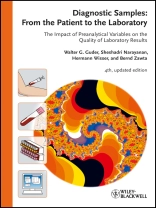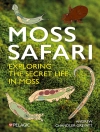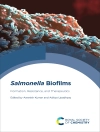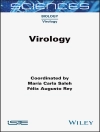This fourth, updated edition contains the latest developments in analytical techniques. An international team of authors summarizes the information on biological influences, analytical interferences and on the variables affecting the collection, transport and storage, as well as preparation of samples. In so doing, they cover age, gender, race, pregnancy, diet, exercise and altitude, plus the effects of stimulants and drugs. National and international standards are described for sampling procedures, transport, sample identification and all safety aspects, while quality assurance procedures are shown for total laboratory management.
In addition, this practical book contains a glossary as well as a separate list of analytes containing the available data on reference intervals, biological half-life times, stability and influence and interference factors.
For everyone involved in patient care and using or performing laboratory tests.
Jadual kandungan
Dream and reality –
An introductory case –
The importance of the preanalytical phase
BIOLOGICAL INFLUENCES
Something unavoidable –
Influences of age, gender, race and pregnancy
Changing habits –
Influences that can vary (diet, starvation, exercise, altitude)
May I take coffee, smoke or drink before blood sampling? –
Stimulants and addictive drugs as biological influence factors
What if I take herbs? –
Effects of herbs on laboratory results
COLLECTION OF SPECIMEN
When to test? –
Timing of sampling
Sampling during infusion therapy? –
Sequence of diagnostic and therapeutic procedures
Sampling in the supine or upright position? –
Effects of posture and tourniquet
What site for sampling blood? –
Phlebotomy, arterial puncture and sampling from catheters
Blood from the skin –
Capillary sampling
Did the lab mix up my sample? –
Techniques of sample identification
A precious sample –
Cerebrospinal fluid (CSF)
A sample that is nearly always available –
Urine and saliva as diagnostic probes
Plasma or serum? –
Differences to be considered
Take a lavender tube! –
Additives and colour codes
TRANSPORT AND STORAGE
Fax me a sample –
Effects of time and temperature during transport
Samples in transit –
Legal standardization for mailing samples
How to keep a sample ‘fresh’ –
Storage of samples in the laboratory
PREPARATION OF SAMPLES FOR ANALYSIS
What has to be done on specimen arrival? –
Specimen processing, centrifugation, distribution
Continuous or batchwise? –
Preanalytical workflow and robotics
Safety aspects during the preanalytical phase –
Disposal of specimens, needles, tubes and chemicals
SPECIAL ASPECTS WITH EACH ANALYTE
What is needed before blood transfusion? –
Special aspects in immuno-haematology
Why a separate tube for the coagulation test? –
Special aspects in haemostaseology
Blood cells are sensitive! –
Special aspects in haematological analysis
Everything from a drop of blood? –
Special aspects in clinical chemistry
Special tubes for hormones and proteomics? –
Preanalytical factors in immunoassays
Blood cells can provide important information –
Special aspects in cellular analysis
How to handle genes –
Special aspects in molecular biology
When gases evaporate –
Special aspects for blood gases and ionized calcium
The right time for drugs? –
Special aspects in therapeutic drug monitoring (TDM)
Bacteria, fungi, parasites and viruses –
Special aspects in microbiology
ENDOGENOUS AND EXOGENOUS INTERFERENCES
Can turbid samples be used? –
Effects of lipaemia
A difficult case –
Pitfalls with endogenous antibodies
The serum sample looks reddish –
Effects of haemolysis
Does the laboratory have to know all my drugs? –
Mechanisms and treatment of drug interference
Everything under control? –
Quality assurance in the preanalytical phase
References
Glossary
Index
Mengenai Pengarang
Until Jan 2003
Prof. Dr. Walter G. Guder was Director of the Institute of Clinical Chemistry, Bogenhausen Community Hospital Munich and Professor of Clinical Biochemistry at the Ludwig-Maximilians-University of Munich. He studied medicine in Cologne, Tübingen and Munich. He served as President of the German Society of Clinical Chemistry and was Chairman of the Working Group on Preanalytical Quality. He is Editor of the “Laborbuch für Klinik und Praxis” and Administrator of the Internet Program www.diagnosticsample.com.
Prof. Dr. Sheshadri Narayanan is an Adjunct Clinical Professor of Pathology and Laboratory Medicine at the Weill Medical College of Cornell University, New York City. He is a diplomate of the American Board of Clinical Chemistry and is qualified to act as Clinical Laboratory Director in the States of New York and New Jersey. Besides the many publications he has also authored a book on “Principles and Applications of Laboratory Instrumentation” and co-authored with Prof. Donald S. Young a book on “Effects of Herbs and Natural Products on Clinical Laboratory Tests”.
Prof. Dr. Dr. Hermann Wisser studied medicine and chemistry at the universities of Marburg, Göttingen and Mainz. He completed his education in laboratory medicine in Munich and Hannover. Thereafter he served as head of the Department of Laboratory Medicine of the Robert Bosch Hospital in Stuttgart and of the Institut of Clinical Chemistry of the University Hospital Mannheim. He was President of the German Society of Clinical Chemistry and President of the Forum of the European Societies of Clinical Chemistry.
Until he died in 2004 Dr. Bernd Zawta was Head of the Department of Scientific Customer Support and Public Relations of Roche Diagnostics Gmb H. He studied chemistry at the Technical University, Dresden, where he made his thesis on “The chromatography of steroid hormones”. He was editor of more than 20 brochures on the diagnostic application of tests in human diseases. Dr. Zawta served as WHO consultant in Mongolia in 1985. He died just before finishing a teaching program “Focus Patient Sample” together with Guder, Hagemann and Wisser.












